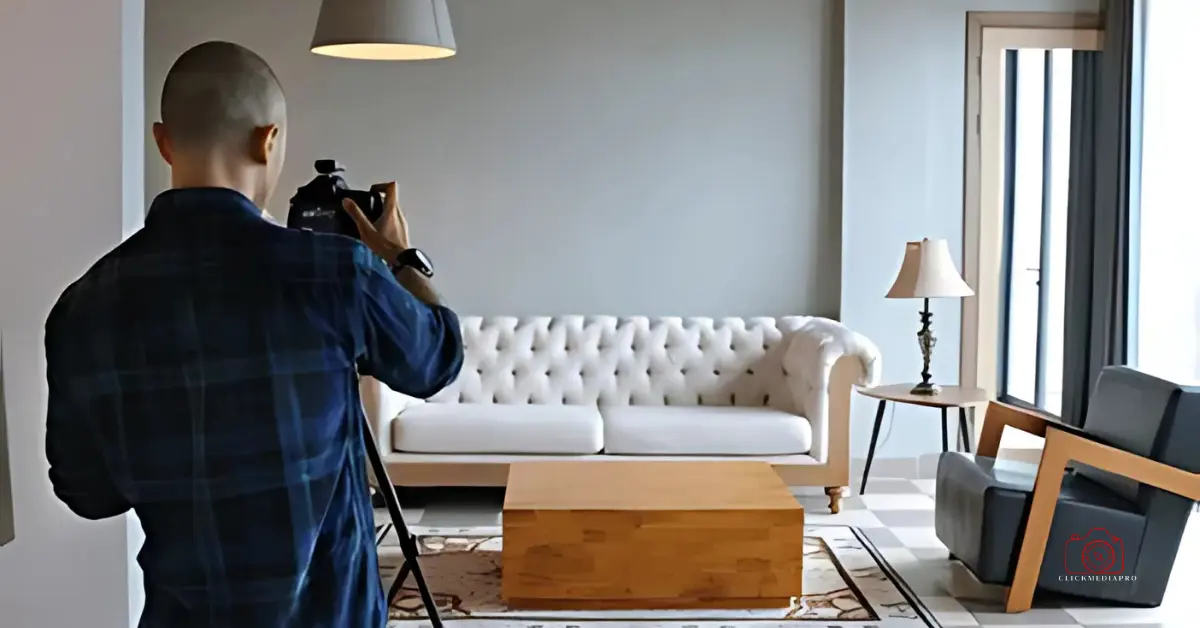Wide-Angle Lenses in Real Estate Photography – Real estate photography plays a crucial role in showcasing a property to prospective buyers. In today’s digital age, where the first impression is often made online, it is essential to present the property in the most compelling way possible. One of the most effective tools for achieving stunning, impactful real estate photos is the wide-angle lens.
While interior spaces can sometimes be tricky to photograph due to constraints in space, wide-angle lenses offer numerous advantages in capturing the essence of a home. They provide a greater field of view, which allows photographers to take in more of the scene, making small rooms appear larger and providing potential buyers with a complete visual experience.
In this blog, we will explore the benefits of using wide-angle lenses in interior real estate photography, tips for effectively using them, and the different types of wide-angle lenses available. Whether you’re a seasoned real estate photographer or a homeowner trying to capture the perfect listing photos, understanding the power of wide-angle lenses will significantly enhance the quality of your shots.
Table of Contents
ToggleWhat Is a Wide-Angle Lens?
A wide-angle lens is any lens with a focal length shorter than a standard lens, typically less than 35mm. This allows the photographer to capture a broader field of view, which is ideal for photographing small or tight spaces, as well as showing the context and flow of the entire room. Wide-angle lenses can range from moderate to extreme wide angles, with some offering a field of view as wide as 180 degrees.
In real estate photography, wide-angle lenses typically fall within the 16mm to 35mm range, depending on the specific needs of the shoot. For interior shots, the most commonly used lenses are between 16mm and 24mm for crop-sensor cameras, and between 24mm and 35mm for full-frame cameras.
Benefits of Using Wide-Angle Lenses in Interior Real Estate Photography
Wide-angle lenses are often considered a staple in interior real estate photography. Here are some key benefits of using them:
1. Maximizing Space in Small Rooms
One of the main advantages of wide-angle lenses is their ability to capture more of the room in a single shot. Small or cramped spaces, such as bathrooms, kitchens, and bedrooms, can be difficult to photograph with standard lenses. Without the ability to show the entire space, these rooms may appear less appealing to potential buyers.
By using a wide-angle lens, photographers can include more of the room in their shots, making the space appear larger and more open. For example, a small living room can be photographed from a corner using a wide-angle lens to give a broader perspective, showcasing not only the room’s furnishings but also its relationship with the rest of the space.
2. Creating a Sense of Depth and Perspective
Wide-angle lenses have the unique ability to create a sense of depth and perspective that helps make interior spaces feel more immersive. When photographing a room, wide-angle lenses can emphasize the foreground, drawing attention to key features like furniture, architectural details, or artwork, while simultaneously incorporating the background to offer a more complete view of the entire room.
This depth of field can make spaces feel larger and more dynamic. For example, by placing the camera near a piece of furniture and focusing on it with a wide-angle lens, you can create the illusion of a grand, expansive room that would otherwise appear narrow with a standard lens.
3. Highlighting Architectural Features and Design
Wide-angle lenses are excellent for capturing architectural details and design elements in a room. Features such as vaulted ceilings, expansive windows, or intricate trim work are often a focal point in real estate listings. These features are best showcased with wide-angle lenses, which allow the photographer to frame the entire room while emphasizing the grandeur of these design elements.
The ability to photograph an entire room, while still highlighting specific architectural features, allows buyers to visualize how these elements enhance the space and the overall ambiance of the home.
4. Offering a Comprehensive View of the Space
Real estate photography is not just about showcasing individual rooms, but about providing a comprehensive view of the entire property. Wide-angle lenses help achieve this by capturing more of the room in a single frame, making it easier for potential buyers to understand the layout and flow of the space.
Wide-angle shots are particularly useful when photographing open-concept living areas, as they allow you to capture both the living room and the dining area, or the kitchen and family room, in one shot. This helps potential buyers visualize how the spaces work together, giving them a clearer idea of the property’s overall layout.
5. Conveying a Comfortable and Welcoming Atmosphere
Wide-angle lenses can help create a more inviting and comfortable feel in real estate photos. The ability to capture larger portions of the room in a single shot allows photographers to include more elements of the space that contribute to its coziness, such as plush furniture, warm lighting, and decorative touches like throw pillows, rugs, and curtains.
In addition, wide-angle lenses can enhance the natural lighting in a room, especially when placed near a window or glass door. The combination of well-lit spaces and a larger field of view creates an atmosphere that feels open, airy, and welcoming—appealing to buyers who value comfort and functionality.
Discover the latest preconstruction homes in Markham, Ontario and explore exclusive opportunities to secure your dream home at unbeatable prices.
6. Showcasing the Flow Between Rooms
In many homes, particularly those with open floor plans, it’s important to show how different spaces flow into one another. Wide-angle lenses help to capture this continuous flow by allowing you to photograph several rooms or areas in one shot.
For example, a wide-angle lens can show the living room, dining room, and kitchen all in a single image, demonstrating how they are interconnected. This gives buyers a clear sense of the property’s layout and flow, which is crucial for those who are seeking homes with open, functional spaces.
How to Effectively Use Wide-Angle Lenses in Interior Real Estate Photography
While wide-angle lenses are powerful tools for real estate photographers, it’s important to use them correctly to achieve the best results. Here are some tips for effectively using wide-angle lenses in interior real estate photography:
1. Avoid Over-Exaggerating Space
One of the challenges with wide-angle lenses is the potential to distort the space. When used incorrectly, wide-angle lenses can create an exaggerated sense of space, making rooms appear larger than they actually are. This can be misleading to potential buyers, who may be disappointed when they see the property in person.
To avoid over-distortion, it’s essential to shoot with the lens at a neutral perspective. Don’t aim the camera upward or downward excessively, as this can cause the lines of the room to curve. Keep the camera level and try to maintain an angle that showcases the space as naturally as possible while still taking advantage of the lens’s wide field of view.
Stay updated with expert insights and news on preconstruction projects in Ontario by visiting this comprehensive blog.
2. Use a Tripod for Stability
Wide-angle lenses often require longer exposure times, especially in low-light conditions. Using a tripod ensures that the camera remains stable during the shot, preventing blurriness and ensuring sharp, crisp images. A tripod also allows you to frame your shot more precisely, ensuring that you capture all the necessary elements of the room.
3. Consider the Lighting
Lighting is crucial in any type of photography, but it is especially important when using wide-angle lenses. The wider the angle, the more light you need to ensure the space is properly lit. Natural light is typically the best option, so try to schedule your shoots during the day when the sun is shining, or position the camera to make the most of available windows and light sources.
If shooting at night or in low-light conditions, use artificial lighting such as softbox lights or LED panels to fill in the shadows and brighten up the space. Be mindful of light placement to avoid harsh shadows or hotspots.
4. Pay Attention to Composition
Wide-angle lenses allow you to fit more into the frame, but it’s important to pay attention to composition to avoid cluttering the shot. Keep the focus on key features of the room and ensure that there is a clear focal point in each image. A well-composed shot will draw the viewer’s eye to the most important elements, such as a feature wall, fireplace, or architectural detail.
5. Post-Processing to Correct Distortion
While wide-angle lenses can provide great results, they may introduce some distortion, such as barrel distortion, where straight lines appear to curve. Fortunately, this can be corrected during post-processing. Most photo editing software, such as Adobe Lightroom or Photoshop, has tools for correcting lens distortion, allowing you to straighten lines and ensure the photo looks natural.
Browse the most recent Markham real estate listings to find your perfect property in this thriving Ontario community.
Types of Wide-Angle Lenses for Real Estate Photography
There are several types of wide-angle lenses available, each offering different benefits. Here are some common types:
1. Rectilinear Lenses
Rectilinear lenses are the most common type of wide-angle lens used in real estate photography. These lenses maintain straight lines in the image, meaning the walls, doors, and furniture in the room will appear natural, without any noticeable distortion. This is particularly important in interior photography, where straight lines are often crucial to the aesthetic.
2. Fisheye Lenses
Fisheye lenses provide a much more extreme wide angle, often 180 degrees or more. While they can capture a lot of the space, they can also introduce significant distortion. Fisheye lenses are less commonly used in real estate photography due to this distortion, but they can be useful for showing extremely tight spaces, such as small bathrooms or closets, where every inch matters.
3. Tilt-Shift Lenses
Tilt-shift lenses are more advanced tools that allow you to control perspective and adjust the plane of focus. These lenses are especially useful for real estate photography, as they help to eliminate distortion and ensure the vertical lines of walls remain straight, even when shooting at wide angles.
Explore market trends and tips for buying or selling property in Markham by visiting the ultimate Markham real estate blog.
Conclusion
Wide-angle lenses are an indispensable tool for interior real estate photography, providing numerous benefits in terms of maximizing space, creating a sense of depth, and showcasing architectural details. By understanding how to use these lenses effectively and following best practices for composition, lighting, and post-processing, photographers can produce stunning images that truly highlight the beauty of a property.
Enhance your property listings with stunning visuals by partnering with real estate photography experts in Markham at Click Media Pro.
Whether you’re a professional photographer or a homeowner looking to capture your property in the best light, using a wide-angle lens will help you create compelling, visually appealing photos that engage buyers and help sell homes faster.

